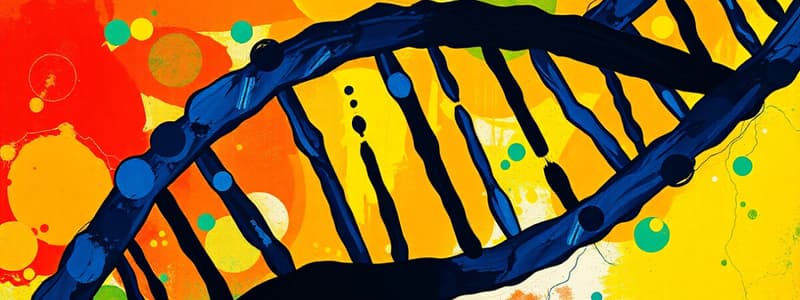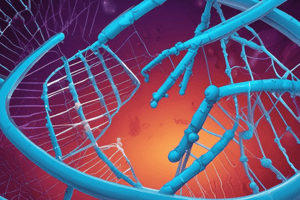Podcast
Questions and Answers
What is the primary purpose of the swab taken from the inner cheek epithelium?
What is the primary purpose of the swab taken from the inner cheek epithelium?
- To isolate and purify DNA from epithelial cells (correct)
- To assess oral hygiene and health
- To perform a genetic test on cheek cells
- To collect saliva for biochemical analysis
Which equipment is essential for the DNA isolation procedure from epithelial cells?
Which equipment is essential for the DNA isolation procedure from epithelial cells?
- Thermal block and vortex
- GeneMATRIX Swab-Extract DNA Purification Kit and laboratory centrifuge (correct)
- Heating block and microtome
- Spectrophotometer and microscope
What should be avoided prior to taking the swab for optimal cell collection?
What should be avoided prior to taking the swab for optimal cell collection?
- Rinsing the mouth with water
- Reading or studying
- Drinking and eating (correct)
- Using mouthwash
What is the first step in the DNA isolation procedure using the mini-column method?
What is the first step in the DNA isolation procedure using the mini-column method?
How long should each cheek be rubbed to optimize the amount of epithelial cells collected?
How long should each cheek be rubbed to optimize the amount of epithelial cells collected?
What is the main role of DNA in living organisms?
What is the main role of DNA in living organisms?
What type of bond connects nucleotides in a DNA strand?
What type of bond connects nucleotides in a DNA strand?
Which nitrogenous base pairs with thymine in DNA?
Which nitrogenous base pairs with thymine in DNA?
Which statement about the structure of DNA is correct?
Which statement about the structure of DNA is correct?
Why are G-C bonds considered stronger than A-T bonds?
Why are G-C bonds considered stronger than A-T bonds?
What feature allows one DNA strand to be used for replication or repair of the other strand?
What feature allows one DNA strand to be used for replication or repair of the other strand?
Which component of nucleotides is found in DNA?
Which component of nucleotides is found in DNA?
What is primarily required for the initial process of isolating DNA from biological materials?
What is primarily required for the initial process of isolating DNA from biological materials?
Which of the following is NOT a common source for DNA extraction in human studies?
Which of the following is NOT a common source for DNA extraction in human studies?
Which stage does NOT take place in the process of DNA isolation?
Which stage does NOT take place in the process of DNA isolation?
What type of preparation is the goal of DNA isolation?
What type of preparation is the goal of DNA isolation?
Which method of DNA isolation would be most appropriate when working with amniotic fluid cells?
Which method of DNA isolation would be most appropriate when working with amniotic fluid cells?
What is the purpose of using an EDTA tube for blood collection in DNA isolation?
What is the purpose of using an EDTA tube for blood collection in DNA isolation?
For which of the following purposes is DNA isolation specifically advantageous?
For which of the following purposes is DNA isolation specifically advantageous?
Which of the following factors does NOT influence the choice of DNA isolation method?
Which of the following factors does NOT influence the choice of DNA isolation method?
What is the primary aim of the purification stage in DNA isolation?
What is the primary aim of the purification stage in DNA isolation?
What is the significance of the A260/A280 ratio in nucleic acid preparation?
What is the significance of the A260/A280 ratio in nucleic acid preparation?
At what wavelength does DNA exhibit its maximum absorbance?
At what wavelength does DNA exhibit its maximum absorbance?
What A260/A280 ratio value indicates significant protein contamination?
What A260/A280 ratio value indicates significant protein contamination?
Which method is NOT mentioned as a DNA isolation technique?
Which method is NOT mentioned as a DNA isolation technique?
What is the role of proteinase K in DNA isolation?
What is the role of proteinase K in DNA isolation?
How should isolated DNA be ideally stored for longevity?
How should isolated DNA be ideally stored for longevity?
Which component absorbs UV light at 280 nm, indicating protein presence?
Which component absorbs UV light at 280 nm, indicating protein presence?
What does an A260/A280 ratio of approximately 1.8 suggest about a sample?
What does an A260/A280 ratio of approximately 1.8 suggest about a sample?
Which layer of the obtained lysate contains nucleic acids after extraction?
Which layer of the obtained lysate contains nucleic acids after extraction?
Which substance is used primarily for the extraction of DNA through organic methods?
Which substance is used primarily for the extraction of DNA through organic methods?
What is the function of proteinase K in DNA isolation?
What is the function of proteinase K in DNA isolation?
Which of the following aspects is NOT altered during the cell lysis process?
Which of the following aspects is NOT altered during the cell lysis process?
Which compound is commonly used to precipitate DNA during isolation?
Which compound is commonly used to precipitate DNA during isolation?
During the column-based DNA isolation, what happens to the unbound impurities?
During the column-based DNA isolation, what happens to the unbound impurities?
In magnetic DNA isolation, what is the initial action taken in the procedure?
In magnetic DNA isolation, what is the initial action taken in the procedure?
What type of buffer is typically used for elution in DNA isolation procedures?
What type of buffer is typically used for elution in DNA isolation procedures?
Which layer of the lysate contains denatured proteins after extraction with phenol and chloroform?
Which layer of the lysate contains denatured proteins after extraction with phenol and chloroform?
What is the purpose of the washing steps in column-based DNA isolation?
What is the purpose of the washing steps in column-based DNA isolation?
What role do sodium ions play in the DNA isolation process?
What role do sodium ions play in the DNA isolation process?
Which step follows after the DNA is bound to the magnetic beads?
Which step follows after the DNA is bound to the magnetic beads?
Flashcards
DNA Composition
DNA Composition
DNA is made of nucleotides, each containing a nitrogenous base, sugar, and phosphate.
Nucleotides
Nucleotides
Building blocks of DNA, composed of a base, deoxyribose, and phosphate group.
Purines and Pyrimidines
Purines and Pyrimidines
Adenine and guanine are purines; cytosine and thymine are pyrimidines.
DNA Isolation
DNA Isolation
Signup and view all the flashcards
Applications of Isolated DNA
Applications of Isolated DNA
Signup and view all the flashcards
3',5'-Phosphodiester Bonds
3',5'-Phosphodiester Bonds
Signup and view all the flashcards
Complementary Base Pairing
Complementary Base Pairing
Signup and view all the flashcards
Types of Nucleic Acids
Types of Nucleic Acids
Signup and view all the flashcards
Sample Sources for DNA
Sample Sources for DNA
Signup and view all the flashcards
Antiparallel Strands
Antiparallel Strands
Signup and view all the flashcards
Hydrogen Bonds in DNA
Hydrogen Bonds in DNA
Signup and view all the flashcards
EDTA Role
EDTA Role
Signup and view all the flashcards
Stages of DNA Isolation
Stages of DNA Isolation
Signup and view all the flashcards
Cell Lysis
Cell Lysis
Signup and view all the flashcards
Purification in DNA Isolation
Purification in DNA Isolation
Signup and view all the flashcards
DNA Extraction from Blood
DNA Extraction from Blood
Signup and view all the flashcards
Purity of DNA
Purity of DNA
Signup and view all the flashcards
A260/A280 ratio
A260/A280 ratio
Signup and view all the flashcards
Optical density (OD)
Optical density (OD)
Signup and view all the flashcards
Maximum absorbance for DNA
Maximum absorbance for DNA
Signup and view all the flashcards
Protein's maximum absorbance
Protein's maximum absorbance
Signup and view all the flashcards
Contaminant absorbance
Contaminant absorbance
Signup and view all the flashcards
DNA concentration calculation
DNA concentration calculation
Signup and view all the flashcards
DNA storage temperature
DNA storage temperature
Signup and view all the flashcards
Solvent-based DNA isolation
Solvent-based DNA isolation
Signup and view all the flashcards
Cell lysis methods
Cell lysis methods
Signup and view all the flashcards
Swab Technique
Swab Technique
Signup and view all the flashcards
Activation Buffer
Activation Buffer
Signup and view all the flashcards
Epithelial Cells
Epithelial Cells
Signup and view all the flashcards
Purity Assessment
Purity Assessment
Signup and view all the flashcards
Lysate
Lysate
Signup and view all the flashcards
Phenol and Chloroform extraction
Phenol and Chloroform extraction
Signup and view all the flashcards
Aqueous layer
Aqueous layer
Signup and view all the flashcards
DNA precipitation
DNA precipitation
Signup and view all the flashcards
Proteolysis
Proteolysis
Signup and view all the flashcards
Proteinase K
Proteinase K
Signup and view all the flashcards
GeneMATRIX column
GeneMATRIX column
Signup and view all the flashcards
Magnetic method
Magnetic method
Signup and view all the flashcards
Elution
Elution
Signup and view all the flashcards
Centifugation
Centifugation
Signup and view all the flashcards
Study Notes
DNA Isolation
- DNA is a biopolymer, with nucleotides as monomers.
- Nucleotides consist of a nitrogenous base (adenine, guanine, cytosine, or thymine), deoxyribose (a five-carbon sugar), and a phosphate residue.
- Purines (adenine and guanine) are bicyclic, while pyrimidines (cytosine and thymine) are monocyclic.
- DNA typically exists as a double helix, with strands running antiparallel.
- Guanine pairs with cytosine, and adenine pairs with thymine.
- Hydrogen bonds form between base pairs, holding the helix together.
- G-C pairs are stronger (3 hydrogen bonds) than A-T pairs (2 hydrogen bonds).
- The sequence of one DNA strand is complementary to the other.
DNA Isolation Methods
- Researchers use various methods to isolate DNA from different materials (blood, tissues, etc.).
- The resulting DNA needs to be of high molecular weight and purified from proteins and inhibitors.
- Crucial factors influencing isolation method selection include nucleic acid type, source, and material type.
DNA Isolation Stages
- Stage 1: Preparation of biological material (purification, fragmentation, homogenization, buffering).
- Stage 2: Cell disintegration and lysis (releasing DNA).
- Stage 3: Purification (separating DNA from cellular components).
- Stage 4: Concentration (removing low-molecular impurities).
- Stage 5: Quality and quantitative evaluation (e.g., spectrophotometry).
DNA Purity Evaluation
- The A260/A280 ratio measures DNA purity.
- A ratio of ~1.8 suggests pure double-stranded DNA.
- Ratios below 1.8 indicate protein contamination; A ratio of 1.5 suggests approximately 50% protein contamination.
- DNA concentration can be calculated using a standard formula (Cb = Cst * Ab / Ast).
Practical Part
- Preparing a cheek swab for DNA extraction.
- Activating mini-columns before extraction.
- Procedure for cheek cell collection.
- Specific buffer additions, mixing, and incubation times in the DNA isolation procedure.
- Using a spectrophotometer for quality analysis, assessing purity and concentration; calculating expected yield (1-10µg DNA).
Studying That Suits You
Use AI to generate personalized quizzes and flashcards to suit your learning preferences.




